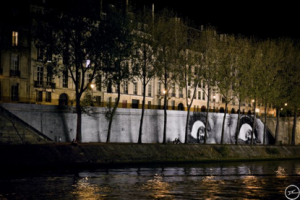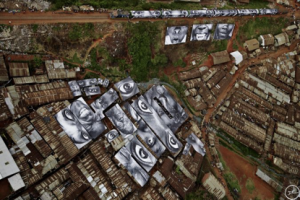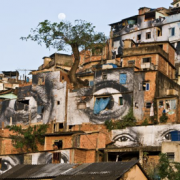Women are heroes by JR
By Juliette Remond-Tiedrez
I went to JR’s exposition Momentum at the Maison Européenne de la Photographie (in English European House of Photography) in Paris mainly because I was interested in one of his projects: Women are heroes.
Maybe I should warn you that, if you decide to go to this exhibition after reading this article, you shouldn’t be surprised if there are only a few pieces of art from Women are heroes at the Maison. This is, first, because Momentum gathers many of JR’s projects and, second, because one who is aware of JR’s style would know that you can find his art mostly outside museums: because “in the street, we reach people who never go to museums”.
I should perhaps explain how JR works for you to understand why his artwork is outdoors. JR is an anonymous 35 years old French photographer who prints large black-and-white images and pastes them on buildings, lorries or other constructions that are in public locations. So for example, in Women are heroes, JR decided to photograph the faces, and more specifically the eyes, of women from all over the world and then to paste them on different constructions, like, in the below photo, on the houses in a favela.

Brazil, Rio de Janeriro, Favela Morro da Providência, 2008
JR explains that he dedicated his Women are heroes project to women and women only because he wanted to pay tribute to “those who play an essential role in society but who are the primary victims of war, crime, rape and political or religious fanaticism”and because, “through the woman’s conditions, sometimes you realise the conditions of the country”.
The project, which includes the gigantic photographs that were taken and pasted throughout the countries JR travelled, a movie, but also pictures of the photographs themselves which can be seen at the Momentum exhibition or online, is a powerful one.
It is powerful, first of all, because of its universality. From 2007 to 2010, JR went to Brazil, Cambodia, India, Kenya, Liberia, and Sierra Leone. The focus, however, is not on where the photos have been taken but rather the women themselves. In the documentary one can guess where they are, but never does JR put a label or a title saying which country he is in. This creates a feeling that the women’s stories could be anyone stories, wherever they are. And the project became truly international when, back from his travels, JR shared his pictures and stories with all of Paris during La Nuit Blanche (The Sleepless Night).

France, Paris, Ile Saint-Louis, 2009
Furthermore, the project deals with a range of topics going from the violence in the favelas, the repression of the civilian population by the government, sexual violence, forced marriage, to poverty. This makes the project even more interesting, in my opinion, as it doesn’t “discriminate” an issue as being less important than another one. JR is not here to decide if he wants to give time to rape or gang violence, or doesn’t do a hierarchy between them, he just gave the floor to those women who then chose what they want to talk about.
I personally find the project powerful also because I feel that the images JR creates couldn’t be stronger. For example, in the documentary, a woman explains that her neighbourhood is being destroyed because of agreements between the local authorities and an enterprise that is interested in the land. And, as the buildings of the neighbourhood are torn down by bulldozers, one can see that the face of the woman, which has been pasted on a wall, is being hammered by a man who is trying to demolish the building. The message couldn’t be clearer: as the man destroys the buildings, he destroys the woman and all of the other inhabitants of the neighbourhood. Another example is the story told by one man in the Kibera slums, Kenya, concerning what the President said that there were no humans in those slums, only cows and pigs. But seeing the eyes of the women pasted on houses and trains, looking at sky from the slums, it cannot be said anymore that there are no humans living in the slums. When a dozen eyes stare at you from Kibera or from the favela, you have to look back and notice them. Tere is no possibility to deny them anymore.

Kenya, Kibera Slum, 2009
And finally, I find the project even more powerful because of the story of one of JR’s piece of art. Still as part of the project, JR pasted eyes on the containers of a ship leaving France for Malaysia. While on its way, the ship met with a boat full of migrants coming from the Libyan coast, rescued them and dropped them in Syracuse, Italy. As mentioned earlier I liked that Women are heroes touched upon a number of issues, and here, without the artist even wanting it, the piece of art dealt with a new issue: migration. The symbol of a Women are heroes eyed boat rescuing migrants at sea is particularly beautiful.

France, le Havre, 2014
I should probably conclude this article by saying that I, of course, recommend Momentum but I above all recommend following what JR is doing because, as I explained before, his art cannot only be found indoors, in a museum. If you, reader, decide to go to the exhibition you will only see a few pictures and small models of what the street artworks looked like. But hopefully this post will have helped you to understand what hides behind those women’s eyes and what the bigger picture is.
And in any case, the exhibition is worth going to as nearly all of JR’s projects have a social aspect behind them, a bottom line that seems to be that he wants to change the world, little by little, through art. You can, for example see his famous Chronicles of Clichy Montfermeil, a place where two teenagers died electrocuted after hiding in an electric plant station because they were fleeing from the police, his animated Guns in America animated fresco, his anti-segregation I Am a Man photograph, etc.

